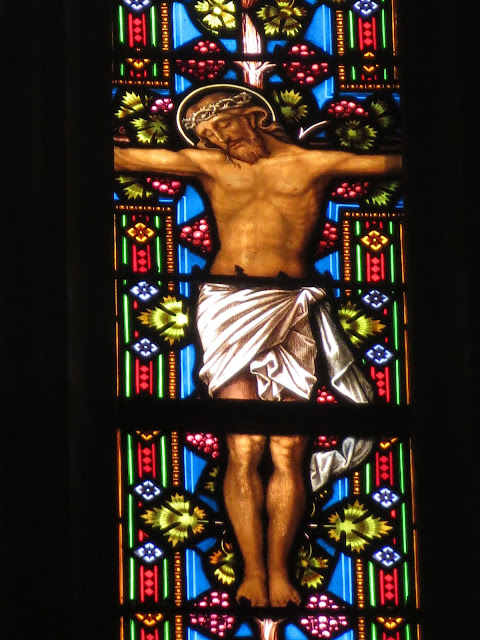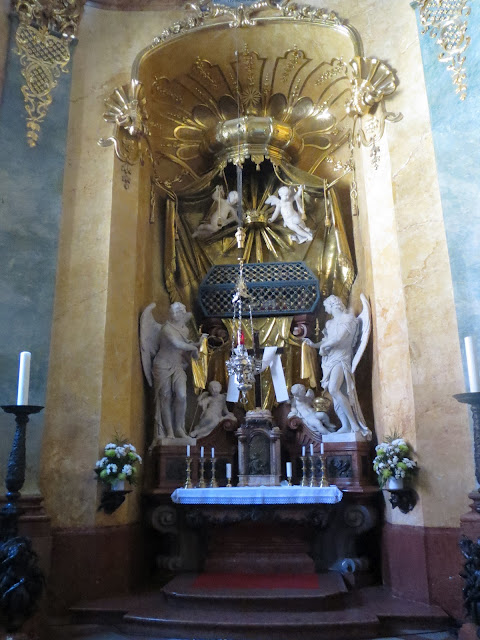Judy and Bob wanted to take a quick detour into Slovakia, kind of a "bucket list" item of places to check off of their list of places to visit. By now Stan and I have learned the Cannons always have great and interesting ideas and we were willing companions in their adventures. Slovakia turned out to be a unique and interesting country, and I'm glad we had the time to go there. We took a train to Bratislava, the capital of Slovakia.
Slovakia has a completely different feel than the other places we'd been thus far.
We noted a lot more crumbling, decrypted, but beautiful old buildings, and there was just a general air of "not enough money". Slovakia just doesn't seem to have joined Western Europe with the same prosperity as other Eastern countries.
Although this is a city of nearly half a million people, there didn't seem to be the bustling business or tourist activity we'd seen other places. Nor was there the English translations on buildings and city attractions us ugly Americans depended on.
This is the back of the Grassalkovic Palace, built in 1760. In 1919 it was taken over by the military, then used as the seat of the government in 1939. A monument back here said "On Sunday 25th August 1878, electric light sparkled in the garden of Grassalkovich Palace, for the first time in our country and later it spread to the windows of houses and factories, to the streets and parks of our towns.....let there be light".
In 1950 it was used as an "activity center" for Slovakian school children. They caused extensive damage (seriously, who didn't see that coming??), but there were no funds to restore it until 1989-90, following the fall of Communism. It became Slovakia's "White House" in 1996.
Sculpture entitled "Joy of Life" (1983) in waterless fountain.
The front of the building was much more impressive.
It had the requisite guy in colorful coat and fancy hat guarding things. Our White House needs a couple of these fellas to liven things up.
This sculpture is called "Earth-Planet of Peace" and was created by the same three artists who did the "Joy of Life" fountain behind this building. This one is in the main square in front of the palace. Note the Crowne Plaza in the background. You know you've arrived when you have the same hotel as Billings, Montana.
Another fountain sans spouting water. This one is entitle----wait for it-
"Diviner".
One sad thing we learned about Slovakia is that they sold their ancient, original cobblestones to other European cities after World War II to pay for necessities in their own land. As a communist country, there wasn't a lot of emphasis on protecting historical culture and beauty.
We were also told that many buildings have cannonballs in them, left in the places they landed in building walls as they were hit in various wars. The skeptic in me couldn't help noticing that many of these cannonballs seemed a bit too centered and prominent to be authentic.
Judy and I, stopping to chat with this guy about his indiscriminate shooting of cannonballs into beautiful ancient buildings.
Love this door. Stan, can we get a new garage door?
I have absolutely loved the art in Europe, from the paintings to the fountains to the sculpture.
The U.S. just doesn't have the variety and quality of art that seems to be so much a part of the culture and history of Europe. This one is so charming.
That copper steeple behind the yellow building is part of St. Micheal's gate.
Built in 1300, it is among the oldest town buildings. It was refurnished in 1758.
Jesuit church and city museum in Old Town.
Do nuns in the USA still wear habits?
Our next stop was St. Martin's Cathedral. The very first church was built in 1221, but as with all things old and European, a new church was built on its place beginning in 1311 and finished in 1452. And of course, the church was renovated and restored a number of times since 1452 due to wars, fires, lightening strikes, earthquakes, and other disasters. St. Martin's was originally built right into the city wall and thus became part of the city fortification.
The design of this building is a simple, clean-lined Gothic style.
Many, many coronations of Hungarian royalty took place in this cathedral.
We saw a lot of silver organ pipes. Somehow, that look was just too modern to me--I felt like they should have been gold.
The ceiling in this church was absolutely stunning.
Beautiful stained glass is this church....
I like this Mary. She seems more appropriately middle age than many depictions I've seen.
A little blurry-but I like this tender scene.
I love this Garden of Gethsemane depiction with the angel, the cup, and beautiful filigree tree.
This is the famous St. Martin sculpture by Georg Rafael Donner. This is the story that goes with it: St Martin was a soldier in the Roman army. One day as he approached a city, he met a scantily clad beggar. He cuts his own military cloak in half and shares it with the beggar. That night, Martin dreams of Christ wearing the half-cloak he has given away to the beggar. He hears Jesus say "Here is Martin soldier who is not baptized; he has clad me."
Isn't that wonderful story?
Like many churches of the day, St. Martins is built over a cemetery. I think I read this book--Nancy "Judy" Drew and the Mystery of the Catacombs.
The crypts in these catacombs contain such dignitaries as famous religious and political figures, and J. I. Bajza, Catholic priest, best known for writing the first Slovakian novel around the 1780's.
St. Martin's is also well-known as the possessor of the 7th century body of St. John the Merciful. This is not the spot.
He is upstairs in this fanciful spot.
Part of the original wall of the city.
In their most practical Communist fashion, the powers that be decided at one point to built a freeway RIGHT next to St. Martin's. In 1967 this lovely, but (not) surprisingly controversial bridge with its space needle feature was built. As you walk through Old Town and St. Martin's, it seems even more obnoxiously Star Trekky than this picture appears. To add insult to injury, the rumblings of constant traffic along the freeway and bridge is slowly destroying the old St. Martin's cathedral.
One other item of note: while in Slovakia, we sample doner kebab, a ubiquitous European fast food.
Yeah, we could eat this often.
At the end of the day, we once again boarded the train and headed to Budapest.
We were happy to be greeted by Alex and Julie, our excellent tour guides for the next leg of our journey.



















































Yeah the cannon balls do seem to fit just a little two well. I'm sure Napoleon aimed it just right, knowing it would be a tourist attraction.
ReplyDeleteI love your shots of the stained glass windows. These seemed especially tender depictions of Christ. I'm glad Bob dragged us all here.
ReplyDeleteThis is one of my favorite posts from this part of your trip. Loved your photos!
ReplyDelete